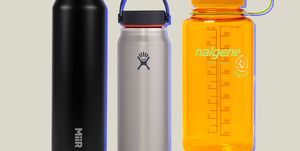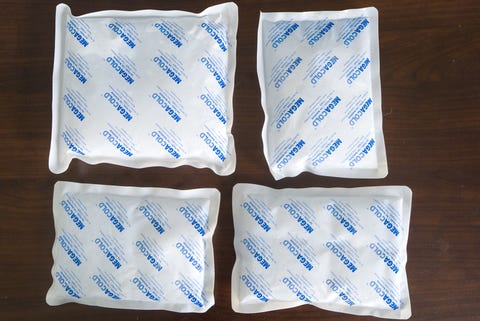The summer is officially over, but throughout the East Coast and beyond, temperatures are still sneaking up to scorching in September and maybe beyond.
The obvious way to beat the heat is to stay indoors or stick to the shade, but not everyone has that luxury. That's where cooling vests come in. If you watch high-performance sports, you may have seen bikers in the Tour De France or Formula 1 drivers at the notoriously hot and humid Singapore Grand Prix wearing slightly bulky and sometimes colorful bits of kit over their torsos, ahead or even during the events themselves.
It's enough to make one wonder: Would a vest stuffed full of ice packs help ease my suffering while I mow the lawn? I can tell you, the answer is "Sort of!" but first, lets go over some of the basics.
What Are Cooling Vests?
Left to its own devices, your body cools itself with sweat. You squeeze a bunch of liquid out of your pores, and as it evaporates from liquid to gas in the heat of the sun, it pulls heat out of your body to complete the transformation. This is all well and good, but for a few drawbacks you know all too well. You have to keep yourself full up with water (or other beverage if your intensity calls for it). If it’s humid out and air is full of water already, your sweat won’t evaporate very quickly. And even when the system works well, it’s just unpleasant!
Cooling vests can help aid this process in a few different ways. Evaporative cooling vests essentially help cool your body by adding extra, artificial sweat. You dip them in water, and as that evaporates from the vest’s porous, quick-drying structure, you get the cooling effect of sweat without having to sweat your own sweaty sweat.
Ice cooling vests hold actual frozen ice (or ice packs) close to your skin. These packs take heat energy from your body as they phase-shift from solid to liquid, and then take even more as they come up to body temperature after fully liquified. Ice-based vests try to locate their cooling power in areas with lots of surface area and bloodflow, like your back.
Each has its pros and cons. Evaporative vests are flexible and easy to ‘”recharge”— just dunk it in water! But they won’t work well in humid conditions, just like your body won’t. Ice cooling vests are instantly and acutely effective, but they’re bulky and rigid until the ice melts. Not to mention they're a bit of shock to put on, and can be hard to recharge on the go.
There are, of course, some “cooling vests” that involve fans or actual air conditioning units, but those are, for the time being, mostly gimmicks because they tend to generate as much heat as they remove.
Do Cooling Vests Work?
In one sense, obviously yes. Your body will be cooler if you strap a bunch of ice packs to your torso. The related questions, “How much cooler?” and, “Cooler in a way that matters?” are tougher to answer due to the huge number of confounding variables, not limited to differences in individual physiology and the difficulty in measuring the perception of comfort.
But there are a number of scientific studies that can point to some objective effects. A study conducted at the 2004 Olympics in Athens showed that cross-country runners who pre-chilled with an ice vest finished their race with a lower overall body temperature than racers who didn’t.
A study of firefighters suggests that an ice vest, “reduces physiological and subjective strain responses during heavy work in the heat, and may promote efficient work time by 10%.” By contrast, a study of surgeons wearing cooling vests showed that while their overall comfort was increased, their performance was not.
What It’s Like to Wear a Cooling Vest
Because the notion intrigued me so much (and I like to pretend I’m a race car driver), I’ve been trying out a cooling vest from Velotoze in this past late-summer East Coast heat wave. Designed primarily for cyclists, the vest has a snug fit with pockets for four ice backs — a large one at the top of the back, a smaller one beneath it, and two small ones on the side of the torso.
I put it through a few tests, the most extreme was a 4PM run in 90-degree New Jersey heat. Maybe unsurprisingly, my 5K time was pathetic and sluggish. I’ll admit, I lightly hoped that an ice vest would be an absolute panacea but that is (obviously) not the case. During my run, and an hour-long stint of lawn-mowing in similar weather the next day, I found the vest’s skin-cooling effect to be quite pleasant in the brutal heat, but I certainly do not feel like it helped me sweat any less or feel markedly less miserable. Did it keep me further from dangerous heat-related injury? Probably, but it’s hard to know for sure.
I found the vest unexpectedly comfortable to wear, but a snug fit is essential. The more free the ice packs are to move, the more exponentially uncomfortable they become, especially when fully frozen. Once your body has had a few minutes to start melting them down and they can mold to your body, things get more comfortable.
I was also pleasantly surprised at how subtle this particular vest is. While the silhouettes of cooling vests obviously vary by design, I found the Velotoze pretty easy to hide under a button-down shirt, especially if I removed the upper-back ice pack. I don’t live in New York City anymore, but if I did, I would absolutely try wearing a vest like this on a summer morning commute (and take it off once I got to the office).
Do You Need a Cooling Vest?
Probably not! At least, not yet. Professional athletes have no real choice but to perform in extreme conditions, but if you’re a desk jockey like I am, you almost certainly do. And you could probably do without the encouragement to try. But if you’re unlucky enough to have to labor in sweltering conditions where airconditioning is impossible, it might be worth a try, even if you opt for a smaller neck-type cooling implement before shelling out for a whole cooling vest and the logistical headaches that entails.
Looming in the distance, however, is the specter of climate change. As peak temperatures increase worldwide, cooling vests may become useful, if not essential, in certain parts of the world. There are combinations of temperature and humidity under which the human body becomes completely unable to regulate its temperature by natural means, even with unlimited shade and water, because sweat simply stops working. These conditions have historically been rare, but if they become more common, cooling vests may become an essential counterpart to air conditioning.
For the time being, and in most locales, cooling vests are a luxury and one that won't necessarily save you from simmering in your own sweat when the sun gets sweltering. But if you could use a little pick-me-up, something to help you slink out the door into the sticky heat or save your sanity in a stuffy room where the aircon can't reach, you could certainly do worse.






















